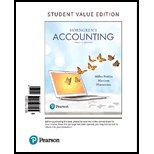
On January 1, 2018, a business borrowed $18,000 on a five-year, 5% note payable. At December 31, 2018, the business should record
Learning Objective 1
- interest payable of $900.
- note receivable of $18,000.
- cash payment of $18,000.
- nothing. (The note is already on the books.)
Note Payable: Note Payable is a written agreement under which the Borrower obtains a certain sum of money from the Lender for a specific period of time. It carries a specific rate of interest. The borrowed sum along with interest is to be returned to the Lender after the expiry of the specified time period
To determine:
What entry should be record at the yearend i.e. December 31, 2018
Answer to Problem 1QC
Solution:
a. Interest payable of $900
Explanation of Solution
• Given:
On January 1, 2018, a business borrowed $18000 on a 5 year, 5% note payable.
• Formula used:
Interest Amount = Borrowed Sum * Interest Rate* Time Period
• Calculation:
Interest Amount = $18000*5%*1year
■ = $900
• According to the accrual basis of accounting, interest on note payable should be accrued in the books of accounts irrespective of its payment. It means although payment of interest has not been done, but the same must be recorded in the books of accounts because the interest is accrued on note payable. While recording this transaction, an expense is booked and a liability is created simultaneously. Here, in this question, the business should record interest payable of $900 at the year end. This is because the business has used the borrowed amount for 1year and for this usage of money, interest becomes payable to the lender. Although the interest has not been paid, but the same must be recorded in the books since it has been accrued. The Journal entry in this case would be:
Interest Expense Dr $900
To Interest Payable $900
(Being interest on note payable accrued for 1 year)
From the above discussion, we can conclude that the business should record interest payable of $900 at December 31, 2018 following the accrual basis of accounting.
Want to see more full solutions like this?
Chapter 11 Solutions
Horngren's Accounting, Student Value Edition (12th Edition)
- I am trying to find the accurate solution to this general accounting problem with the correct explanation.arrow_forwardI am trying to find the accurate solution to this general accounting problem with appropriate explanations.arrow_forwardHow can I solve this financial accounting problem using the appropriate financial process?arrow_forward

 AccountingAccountingISBN:9781337272094Author:WARREN, Carl S., Reeve, James M., Duchac, Jonathan E.Publisher:Cengage Learning,
AccountingAccountingISBN:9781337272094Author:WARREN, Carl S., Reeve, James M., Duchac, Jonathan E.Publisher:Cengage Learning, Accounting Information SystemsAccountingISBN:9781337619202Author:Hall, James A.Publisher:Cengage Learning,
Accounting Information SystemsAccountingISBN:9781337619202Author:Hall, James A.Publisher:Cengage Learning, Horngren's Cost Accounting: A Managerial Emphasis...AccountingISBN:9780134475585Author:Srikant M. Datar, Madhav V. RajanPublisher:PEARSON
Horngren's Cost Accounting: A Managerial Emphasis...AccountingISBN:9780134475585Author:Srikant M. Datar, Madhav V. RajanPublisher:PEARSON Intermediate AccountingAccountingISBN:9781259722660Author:J. David Spiceland, Mark W. Nelson, Wayne M ThomasPublisher:McGraw-Hill Education
Intermediate AccountingAccountingISBN:9781259722660Author:J. David Spiceland, Mark W. Nelson, Wayne M ThomasPublisher:McGraw-Hill Education Financial and Managerial AccountingAccountingISBN:9781259726705Author:John J Wild, Ken W. Shaw, Barbara Chiappetta Fundamental Accounting PrinciplesPublisher:McGraw-Hill Education
Financial and Managerial AccountingAccountingISBN:9781259726705Author:John J Wild, Ken W. Shaw, Barbara Chiappetta Fundamental Accounting PrinciplesPublisher:McGraw-Hill Education





